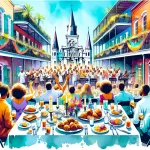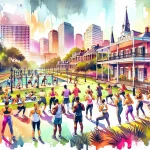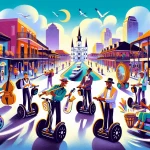New Orleans, a captivating city acclaimed for its rich cultural blend, lively atmosphere, and mouthwatering cuisine, presents a truly distinct experience for travelers. As you plan your journey to this enthralling destination, consider these essential travel tips to maximize your adventure.
In This Article
TL;DR
- The ideal times to visit are spring and fall when the weather is pleasant, and popular festivals like Mardi Gras and Jazz Fest take place.
- Must-try local specialties include gumbo, jambalaya, po’boys, and beignets, found at iconic eateries like Dooky Chase’s, Galatoire’s, and Café du Monde.
- Navigate safely by utilizing the streetcar system, sticking to well-lit areas, and remaining vigilant, especially in the French Quarter at night.
Understanding New Orleans’ Unique Culture
New Orleans is a melting pot of French, African, Spanish, and other cultural influences, creating a truly distinct atmosphere. Music and festivals are the heartbeat of local life, with events like Mardi Gras and Jazz Fest showcasing the city’s lively spirit. To respectfully participate in cultural events, research the history and traditions beforehand, dress appropriately, and follow local customs and etiquette.
When to Visit: Timing Your Trip
New Orleans has a subtropical climate, with hot, humid summers and mild winters. The most popular times to visit are during the spring and fall when temperatures are more comfortable and major festivals take place. Mardi Gras, usually in February or March, and Jazz Fest in late April and early May, attract large crowds and higher prices. Consider visiting during off-peak seasons like December or January for lower rates and fewer tourists.
Culinary Delights: Eating Like a Local
New Orleans is acclaimed for its Creole and Cajun cuisine, which blend French, African, and Spanish influences. Creole dishes tend to be more refined, while Cajun food is heartier and spicier. Must-try dishes include gumbo (a thick, flavorful soup), jambalaya (a rice dish with meat and vegetables), po’boys (a submarine sandwich), and beignets (a sweet, fried pastry).
For an authentic taste of New Orleans, visit iconic restaurants like Dooky Chase’s (known for its Creole cuisine and civil rights history), Galatoire’s (a classic French-Creole restaurant), and Café du Monde (famous for its beignets and café au lait). Food tours and cooking classes are also great ways to explore the city’s culinary scene and learn about its history and traditions.
Getting Around: Transportation Tips
New Orleans is a walkable city, especially in the French Quarter and downtown areas. The streetcar system is a convenient and affordable way to explore major attractions, with fares starting at $1.25 per ride. Consider purchasing a Jazzy Pass for unlimited rides if you plan on using the streetcar frequently. Taxis, ride-sharing services like Uber and Lyft, and bike rentals are also available.
When navigating the city, be aware of your surroundings and take safety precautions, especially at night. Stick to well-lit areas, avoid walking alone, and keep valuables secure. The French Quarter can be particularly crowded and rowdy, so exercise caution and be mindful of pickpockets.
Accommodation: Where to Stay
New Orleans offers a range of accommodation options, from historic hotels to cozy bed and breakfasts. The French Quarter is the most popular area to stay, with its central location and iconic architecture. Other notable neighborhoods include the Garden District (known for its antebellum mansions), Marigny (a bohemian area with great music venues), and the Central Business District (a modern area with easy access to attractions).
When choosing accommodations, consider your budget, preferred amenities, and proximity to attractions. Book well in advance for the best rates, especially during peak seasons and major festivals. Vacation rentals and homestays can offer more space and local character, but be sure to research the location and read reviews carefully.
Safety and Etiquette: Traveling Smart
While New Orleans is generally a safe city, it’s important to take common-sense precautions to avoid potential issues. Be aware of your surroundings, especially in crowded areas like the French Quarter, and avoid walking alone at night in unfamiliar neighborhoods. Keep valuables secure and be cautious of scams or suspicious activity.
When interacting with locals, be respectful of customs and traditions. Dress appropriately for cultural events and sacred spaces, and ask permission before taking photos of people or private property. Tipping is expected in restaurants, bars, and for services like tours and taxis. In case of emergencies, dial 911 or contact the New Orleans Police Department’s non-emergency line at (504) 821-2222.
Beyond the Beaten Path: Exploring Like a Local
While New Orleans’ popular attractions are must-sees, venturing beyond the tourist areas can reveal hidden gems and authentic experiences. Explore lesser-known neighborhoods like Bywater (known for its street art and dive bars), Mid-City (home to City Park and the New Orleans Museum of Art), and Treme (the birthplace of jazz and African-American culture in the city).
Visit local markets like the French Market (the oldest public market in the country) and the Crescent City Farmers Market (featuring fresh produce and artisanal goods). Shop at independent bookstores like Faulkner House Books (located in the former home of writer William Faulkner) and Beckham’s Bookshop (a cozy spot with a great selection of used books).
Participating in Festivals and Events
New Orleans is known for its lively festivals and events, which celebrate the city’s music, food, and cultural heritage. Mardi Gras, the most famous celebration, takes place in February or March and features parades, costumes, and street parties. To attend, book accommodations and transportation well in advance, purchase tickets for specific events or grandstand seating, and follow local laws and customs (such as not throwing beads back at floats).
Other significant events include Jazz Fest (a 10-day celebration of music and culture in late April and early May), French Quarter Festival (a free music festival in April), and Essence Festival (a celebration of African-American culture and music in July). Research the specific dates, ticket requirements, and schedules for each event, and plan accordingly.






